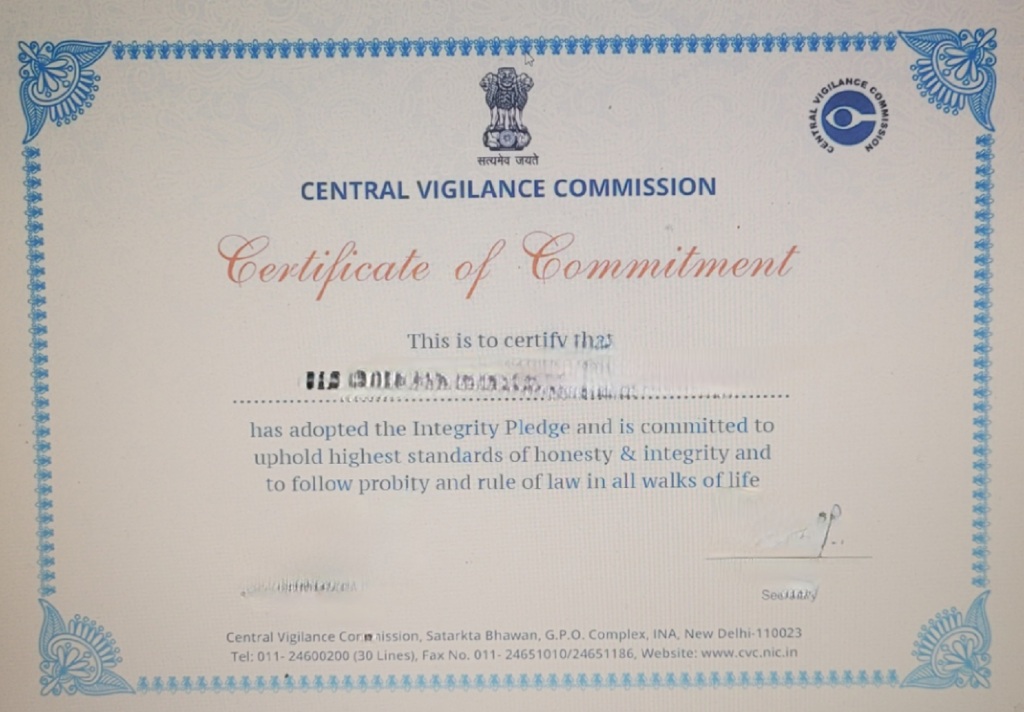
Government of India is observing “Vigilance Awareness Week – VAW’2022” from 31 Oct to 6 Nov’22 with the theme” Corruption Free India for a Developed Nation”. Triggered by one of my close associate I felt it’s apt to address the same from a different perspective, from the mindset of a Common man and more particularly from the view point of a conscious tax payer.
The Central Vigilance Commission (CVC)observes vigilance awareness week every year during the week in which October 31-the birth anniversary of India’s First Home Minister Sardar Vallabhbhai Patel – falls.
CVC is responsible to undertake or cause an inquiry into complaints received under the Public Interest Disclosure and Protection of Informer and recommend appropriate action.
We are expected to be Vigilant at all times even in our sleep as we are not sure of a wake up when we go for a sleep. As I am penning this awareness article I did come across the fateful end of three precious lives few days before, near Urappakkam in Chennai. They faced their end in their sleep due to suffocation caused by the Refrigerator explosion from an electrical short circuit. Such is the short life that each one of us going through. Let us be Vigilant ever with our Surroundings.
Before we jump into the positive outcome of VAW’22, let us delve in detail the theme “Corruption Free India” on a broader outlook.
As a common man it is natural to feel the impact of Corruption at all levels over the years and the Governments remains a mute spectator at most of the times in spite of numerous indictments by the Judiciary.
The causes of Corruption in India include excessive regulations, complicated tax and licensing systems, numerous government departments with opaque bureaucracy and discretionary powers, monopoly of government controlled institutions on certain goods and services delivery, and the lack of transparent laws and processes. This includes officials siphoning off money from government social welfare schemes.
In simple terms “Corruption” is improper or selfish exercise of power and influence attached to a public office or to a special position in public life.
According to a 2017 Survey, greed for money or desires, higher levels of market and political monopolization, Low levels of democracy, weak civil participation and low political transparency, were the major factors that gives shape to the ugly face of Corruption.
Forms of Corruption vary but can include Bribery, Extortion, Lobbying, Cronyism, Nepotism, Parochialism, Patronage, Influence peddling, Graft and Embezzlement.
On a lighter note India is Ranked 85th out of 180 Countries on a Corruption Perceptions Index (CPI) survey published by Transparency International in 2021 on a scale where the lowest –ranked countries are perceived to have the most honest public sector. As per CPI Rankings Denmark, Finland and New Zealand are Ranked Numero Uno followed by Norway, Sweden and Singapore at fourth place, whereas Somalia, Syria and South Sudan are Ranked as the most Corrupt Countries in the World.
CBI has registered 457 Cases of Corruption in 2021 against 549 civil servants including 221 gazetted officers.
Some of the day to day incidents where we indirectly encourage Corruption:
- A Vegetable Vendor in our neighborhood Market is forced to pay Rs.100/- to the Police personnel or the Security every time he has to take his Cart inside the market.
- It is a daily experience of most of us riding a two wheeler to pay Rs.100 to 500/- to the Traffic Police for petty offences in order to avoid hefty fines as stipulated by the Government.
- She is a single Mother of two children, separated from her husband and is forced to approach the Court of Law for her monthly maintenance and each time she has to file a case against her ex-husband for non-payment, forced to bribe the concerned police personnel for filing a case.
On a serious note, we need to understand that Corruption is a serious economic issue as it adversely affects the country’s economic development and achievement of developmental goals. It promotes inefficiencies in utilization of resources, distorts the markets, compromises quality, destroys the environment and of late has become a serious threat to national security. It adds to the deprivation of the poor and weaker sections of the economy.
It is equally disheartening to note that the costs of corruption runs deep in an economy. The Tax Payers’ money is lost in different ways, siphoned off from schools, roads, and hospitals to line the pockets of people up to no good. Equally damaging is the way it corrodes the governments; ability to help grow the economy in a way that benefits all citizens. In effect, the moment taxpayers believe their governments are corrupt, they are more likely to evade paying taxes.
Having put forward the causes and effects of Corruption, it is time to think of preventive measures. One of the strategies successfully deployed by the CVC is by leveraging technology to combat corruption, by persuading organizations to adopt IT and automate the activities and processes vulnerable to corruption. It all started with the Demonetization efforts by the present Indian Government followed by Digitization of Financial Transactions at all levels from Street Vendors to Micro and Medium Enterprises. The results of this exercise have been encouraging and the efforts been recognized internationally.
An important requirement for the success of anti-corruption efforts is that it should be participative and involve all stakeholders and establish coordination among all agencies fighting corruption.
This requires political will to create strong fiscal institutions that promote integrity and accountability throughout the public sector.
Here are some points for the concerned department to help them build effective institutions that curb vulnerabilities to corruption:
- Invest in high levels of transparency and independent external scrutiny: This allows Audit Agencies and the Public at large to come forward and provide effective oversight.
- Reform institutions: The chance for success are greater when we design reforms to tackle corruption from all angles.
- Build a Professional Civil Service: Transparent, merit based hiring and pay reduce opportunities for corruption. The heads of agencies, ministries, and public enterprises must promote ethical behavior by setting a clear tone at the top.
- Keep pace with new challenges as technology and opportunities for wrongdoing evolve.
- Fight Corruption jointly: Bring all involved to a single platform and device joint efforts to fight corruption.

Some of the recent Corruption Scams that rocked the nation and a blow to the economy:
- Stamp Paper Scam of 2002 to the tune of Rs.200 Billion– Abdul Karim Telgi, a convicted Indian Counterfeiter, who earned illegal money for Printing Counterfeit Stamp Paper,
- Stock Market Securities Scam of 2001 to the tune of Rs.320 Million – Ketan Parekh, a former Stock Broker of Mumbai, convicted in 2008 for his involvement in manipulation and rigging of Securities.
- Coalgate Scam of 2009 for Rs. 1,856 Billion, a major Political Scandal involving Government’s allocation of Coal Deposits to Public and Private Sector Companies, unearthed by CAG.
- AGUSTAWESTLAND VVIP Chopper Scam of 2006 for value of Rs.3,600 Crores where it is alleged that deal was signed after due Bribes to middlemen.
Corruption is deep rooted in Bureaucracy especially hospitals, income tax department as also in Tendering and awarding contracts, and invites immediate over hauling.
In line with observance of VAW 2022, the Central Vigilance Commissioner has come out with a notification dated 19 Oct’2022 stating that “ As we progress in the journey towards growth and development, there is an ever-growing need for transparency and integrity in public administration. It is the collective duty and responsibility of all citizens to fight corruption and build a strong and ethical india.”

The Purpose of VAW 2022:
1)Vigilance Awareness Week is one of the tools of the commission in increasing public awareness about the perils of Corruption.
2) All organizations are advised to conduct activities relevant to the theme “ Corruption Free India for a Developed Nation”, that strives to bring maximum public participation.
3) Activities to be conducted may include:
a) Employees may be encouraged to take e-pledge or integrity-pledge by visiting the CVC website (Sample Integrity Pledge Attached)
b) Conduct workshops/sensitization programs for employees and other stake holders, highlighting policies/procedures of CVC on Preventive Vigilance Measures.
c) Conduct various outreach and awareness programs through Vigilance Study Circles.
d) Conduct various Competitions and Quiz programs on issues relating to anti-corruption.
e) Promote the concept of e-integrity pledge by third party with whom the organization deals with.
As a responsible citizen, we are bound to extend total support for all preventive measures taken by CVC, instead of pointing the loop holes found in the system and remain a mute spectator. Let us hope 2022 ends on a high note with flourishing economy and corruption free India.
